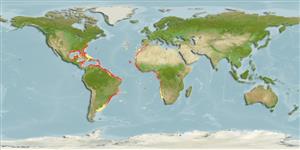इलाज़मौबरांकी (शारक और रेज़) (sharks and rays) >
Carcharhiniformes (Ground sharks) >
Carcharhinidae (Requiem sharks)
Etymology: Carcharhinus: karcharos (Gr.), sharp or jagged; rhinus, an ancient name for sharks, from rhine (Gr.), rasp, both words alluding to a shark's jagged, rasp-like skin (See ETYFish); signatus: Latin for marked, probably referring to indentation on outer margins of upper teeth (described from jaws only) (See ETYFish).
More on author: Poey.
Environment: milieu / climate zone / गहराई सीमा / distribution range
पारिस्थितिकी
समुद्री बेनथोपिलाजिक; गहराई सीमा 0 - 600 m (Ref. 244), usually 50 - 100 m (Ref. 244). Subtropical; 11°C - 16°C (Ref. 244); 39°N - 43°S, 98°W - 15°E (Ref. 55190)
Western Atlantic: Delaware to Florida (USA), Bahamas, and Cuba; southern Brazil, Argentina (Ref. 244). Eastern Atlantic: Senegal to Côte d'Ivoire, Ghana to Cameroon, Democratic Republic of the Congo, Angola, off northern Namibia (Ref. 244, 5578).
Length at first maturity / आकार / वज़न / Age
परिपक्व अवधि: Lm 202.5, range 150 - 205 cm
Max length : 280 cm TL पुल्लिंग / अलिंग; (Ref. 244); common length : 200 cm TL पुल्लिंग / अलिंग; (Ref. 26999); अधिकतम प्रकाशित वज़न: 76.7 kg (Ref. 40637)
पृष्ठीय रीढ़ (सम्पूर्ण) : 0; गुदा कांटा: 0. A slim shark with a very long, pointed snout, large eyes, and small jaws with oblique-cusped serrated upper teeth; dorsal fins low with elongated rear tips; interdorsal ridge present (Ref. 5578). Grey-brown above, white below; no conspicuous fin markings (Ref. 5578).
Body shape (shape guide): fusiform / normal.
Coastal and semi-oceanic species found on or along outer continental and insular shelves (Ref. 244). Found to depths of 40 m (Ref. 26938). Forms schools (Ref. 244). Nocturnal (Ref. 5578), and feeding mainly on small bony fishes and squid (Ref. 244). Viviparous (Ref. 50449). Off West Africa, recorded water parameters at 90 to 285 m, where it was caught includes: temperature = 11 to 16°C; salinity = 36 ppt; oxygen = 1.81 ml/l (Ref. 244). Not known to be dangerous to people (Ref. 244).
Viviparous, placental (Ref. 50449), with 4 to 12 young in a litter (Ref. 244). Size at birth about 60 cm (Ref. 244). Distinct pairing with embrace (Ref. 205).
Compagno, L.J.V., 1984. FAO Species Catalogue. Vol. 4. Sharks of the world. An annotated and illustrated catalogue of shark species known to date. Part 2 - Carcharhiniformes. FAO Fish. Synop. 125(4/2):251-655. Rome: FAO. (Ref. 244)
IUCN Red List Status (Ref. 130435: Version 2025-1)
Human uses
मात्स्यिकी: व्यापारिक; आखेट मत्स्य: हां
साधन
Special reports
Download XML
इंटरनेट स्रोत
Estimates based on models
Preferred temperature (संदर्भ
123201): 15.8 - 27, mean 21.7 °C (based on 178 cells).
Phylogenetic diversity index (संदर्भ
82804): PD
50 = 0.5000 [Uniqueness, from 0.5 = low to 2.0 = high].
Bayesian length-weight: a=0.00468 (0.00303 - 0.00722), b=3.07 (2.95 - 3.19), in cm total length, based on LWR estimates for this species & Genus-body shape (Ref.
93245).
Trophic level (संदर्भ
69278): 4.6 ±0.0 se; based on diet studies.
लौटाव (संदर्भ
120179): बहुत नीचे, न्यूनतम जनसंख्या दुगनी समय अवलागत 14 महीने। (tm=8-10; Fec=4; Tmax=17; K=0.12).
Fishing Vulnerability (Ref.
59153): High to very high vulnerability (73 of 100).
🛈
